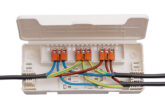
Michael Crowther, Product Development Director at Hylec-APL, explains more about why 4-way junction boxes can help you ensure safe, reliable and compliant electrical installations.
Electrical installers, whether working within domestic or commercial settings, are having to deal with increasing numbers of electrical and electronic devices or fixtures – from LED up- and down-lighting to all kinds of smart home and building automation functionality. This often increases the time, complexity and cost of installations, as well as the risk of quality and compliance issues.
One of the essentials
Junction boxes are an essential piece of kit for electrical installers, functioning as intersections of wiring between fittings or devices and the mains power supply, helping protect and isolate electrical connections. By providing mechanical strength, enclosure and durable electrical continuity, they help wiring installations comply with regulations.
However, not all junction boxes are created equal – and installers must take care they are used in a way that ensures consistently safe, reliable and compliant electrical installations.
Hylec-APL’s in-line junction box series, Debox, which includes 4- and 5-pole models up to 32 Amps, plus the new IP66/67-rated Debox 11 for exterior projects, has been designed to make installers’ lives easier and save installation time by including everything they need – from integrated terminal blocks with rapid connections and cable clamps to tool-less closure and maintenance-free operation.
So, what should electrical installers and contractors look out for when purchasing junction boxes?
1. Is the junction box supplied with a UL/VDE-approved terminal block?
Not all junction boxes come supplied with a terminal block. In fact, contractors often make up kits – sets of boxes, screws, cable ties and terminal blocks – for installers. But there’s always a risk that the installer ends up short of a kit component – and then simply resorts to using whatever connector they have to hand in their toolbox, which then may not be fully compliant. With Debox, integrated UL/VDE-compliant terminal blocks are included.
2. Have the cable clamps been screwed tightly enough?
Across multiple installations, can you be certain that every cable clamp has been secured sufficiently to anchor the cables? To eliminate this concern, Debox SL features quick and easy-to-use push-fit cable clamps, compliant with the EN60670-22 Pull Test.
3. Has the lid been secured correctly?
Junction boxes help conceal and protect electrical connections, as well as protecting users from potentially hazardous wiring. It is therefore vital to ensure that the lid of the junction box is safely secured. If not, the box and its wiring might be accessible, even without tools. Some junction boxes require a cable tie to secure the lid, but this relies on the installer having these to hand – and using them consistently. Debox features an integrated locking clip, for tool-less closure – as well as a spare clip, in case you need to re-visit the connection.
4. Have any of the screws been misplaced during installation?
At the top of a ladder or in poorly lit locations, fiddly parts such as screws can easily be dropped and lost. If they are, will the installer have an exact replacement screw – or will they substitute something else from their toolbox, or even simply skip that one? Debox features an all-integrated design, with no loose components, such as screws or cable ties, that can be accidentally dropped or lost.
So, for busy electrical installers, looking to quickly and methodically wire up multiple devices or fittings on-site, Debox’s integrated design simplifies and guides them through the process, saving time and money – and crucially, ensuring consistently safe, reliable and compliant installations.
To browse the full Hylec Debox product range, click here









